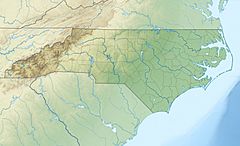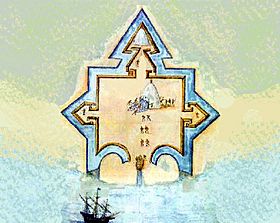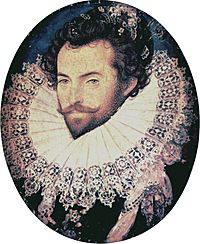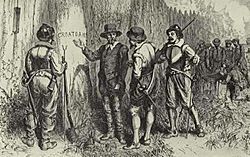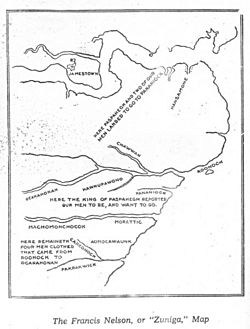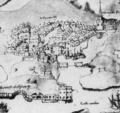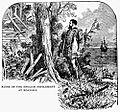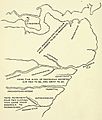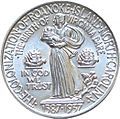Roanoke Colony facts for kids
Quick facts for kids Roanoke Colony |
|
|---|---|
| Colony of England | |
| 1585–1590 | |
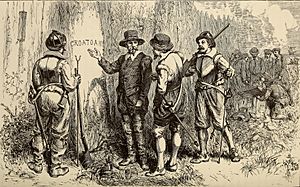
The discovery of the abandoned colony, 1590
|
|
|
Location of Roanoke Colony within what is now North Carolina |
|
| Population | |
|
• 1585
|
Approx. 108 |
|
• 1587
|
Approx. 112–121 |
| Government | |
| Governor | |
|
• 1585–1586
|
Ralph Lane |
|
• 1587
|
John White |
| Historical era | Elizabethan era |
|
• Established
|
1585 |
|
• Evacuated
|
1586 |
|
• Re-established
|
1587 |
|
• Found abandoned
|
1590 |
| Today part of | Dare County, North Carolina, US |
The Roanoke Colony was an early attempt by England to create a lasting settlement in North America. It was started by Sir Walter Raleigh. Before this, in 1583, Sir Humphrey Gilbert had claimed St. John's, Newfoundland for England. This was done with the permission of Queen Elizabeth I.
The first Roanoke colony was set up by Governor Ralph Lane in 1585. It was on Roanoke Island in what is now Dare County, North Carolina, in the United States. This first settlement did not last.
A second group of settlers, led by John White, arrived on the same island in 1587. This settlement later became known as the Lost Colony. This is because everyone living there disappeared without a clear explanation.
Lane's first colony had many problems. They did not have enough supplies. Also, their relationships with the local Native Americans were not good. Sir Richard Grenville was supposed to bring more supplies, but he was late. So, Lane and his group left the colony and went back to England with Sir Francis Drake in 1586.
Grenville arrived two weeks later. He also went home, but he left a small group of men behind. These men were meant to protect England's claim to the land.
In 1587, Raleigh sent John White to start a new colony. This new colony was supposed to be in Chesapeake Bay. But on their way, they stopped at Roanoke to check on Grenville's men. The ship's pilot, Simon Fernandes, made White's colonists stay on Roanoke Island.
White went back to England with Fernandes. He planned to bring more supplies back to his colony in 1588. However, the Anglo-Spanish War delayed his return until 1590. When he finally arrived, he found the settlement empty. It was fortified, but no one was there.
The mysterious word "CROATOAN" was carved into a fence post. White thought this meant the colonists had moved to Croatoan Island. But bad weather and a lost anchor forced White's ships to return to England. He could not follow this lead.
The fate of the 112 to 121 colonists is still a mystery. Some people thought they joined nearby Native American groups. This idea appeared in writings as early as 1605. Later, settlers from Jamestown heard stories. Some reports said the Roanoke settlers were killed. Other stories mentioned people with European features living in Native American villages. But there was no strong proof.
Interest in the colony faded until 1834. That year, George Bancroft wrote about the events in his book A History of the United States. Bancroft's story, especially about White's baby granddaughter Virginia Dare, made the colonists seem like important figures in American culture. This captured the public's imagination. Even with this new interest, modern research has not found archaeological proof to explain the colonists' disappearance.
Contents
- Starting the Colony: Raleigh's Plan
- First Trips to Roanoke Island
- The Lost Colony: A Mystery Unfolds
- Early Reports and Theories
- What Happened to the Lost Colonists?
- Archaeological Finds
- Weather and Climate Factors
- Lost Colony of Roanoke DNA Project
- Stories and Plays About the Colony
- Images for kids
- See also
Starting the Colony: Raleigh's Plan
The idea for the Roanoke Colony first came from Sir Humphrey Gilbert. He sadly drowned in 1583 while trying to colonize St. John's, Newfoundland. Sir Humphrey Gilbert's half-brother, Sir Walter Raleigh, then got the Queen's permission to continue the plan. Raleigh worked through his helpers, Ralph Lane and Richard Grenville, who was a distant cousin.
Queen Elizabeth's Charter
On March 25, 1584, Queen Elizabeth I gave Raleigh a special document called a "charter." This charter gave him permission to start a colony in North America. It also said that if he didn't set up a colony, he would lose this right.
The Queen and Raleigh hoped to find riches in the New World. The charter said Raleigh should "discover, search, find out, and view such remote heathen and barbarous Lands." This meant he could claim and use these new lands.
The Queen also wanted Raleigh to create a base. From this base, English ships could attack Spanish treasure fleets. These attacks were meant to show Spain that England was ready for war. So, the original plan was to build a military base against the Spanish. Raleigh himself never visited North America. However, he did lead trips to South America in 1595 and 1617. He was looking for the legendary golden city of El Dorado along the Orinoco River.
First Trips to Roanoke Island
On April 27, 1584, Raleigh sent an expedition. It was led by Philip Amadas and Arthur Barlowe. Their job was to explore the eastern coast of North America. They arrived at Roanoke Island on July 4. Soon, they met the local Native Americans, the Secotans and Croatoans.
Barlowe went back to England with two Croatoan men, Manteo and Wanchese. These men told Raleigh about the area's politics and geography. Based on this information, Raleigh planned a second expedition. Sir Richard Grenville would lead it.
Grenville's fleet left Plymouth on April 9, 1585. There were five main ships: Tiger, Roebuck, Red Lion, Elizabeth, and Dorothy. A bad storm near Portugal separated Tiger from the others. The captains had a plan if they got separated. They would meet in Puerto Rico. Tiger arrived in "Baye of Muskito" (Guayanilla Bay) on May 11.
While waiting, Grenville made friends with the Spanish living there. At the same time, he also attacked some of their ships. He also built a fort. Elizabeth arrived soon after the fort was built. Grenville eventually got tired of waiting for the other ships. He left on June 7. The fort was left empty, and its exact location is still unknown.
Tiger sailed into Ocracoke Inlet on June 26. But it hit a sandbar, ruining most of the food. The crew fixed the ship. In early July, they met up with Roebuck and Dorothy. These ships had arrived in the Outer Banks with Red Lion some weeks earlier. Red Lion had dropped off its passengers and left for Newfoundland to attack other ships.
Life in the New World
The Europeans explored the mainland coast and Native American villages. During this time, they blamed the people of Aquascogoc village for stealing a silver cup. To get back at them, the settlers attacked and burned the village. English writer Richard Hakluyt also wrote about this event. (Hakluyt's reports were put together from stories by people who helped pay for the trips. Hakluyt himself never went to the New World.)
Even after this incident and with little food, Grenville decided to leave Ralph Lane and 107 men. They were to start a colony at the north end of Roanoke Island. Grenville promised to return in April 1586 with more men and supplies. The group landed on August 17, 1585. They built a small fort on the island. We don't have any pictures of the Roanoke fort. But it was probably like the one in Guayanilla Bay.
April 1586 came and went, but Grenville's supply ships did not appear. In June, the bad feelings from burning the village led to an attack on the fort by local Native Americans. The colonists were able to fight them off.
Soon after the attack, Sir Francis Drake stopped at the colony. He was on his way home from a successful trip in the Caribbean. He offered to take the colonists back to England. Many accepted, including a metal expert named Joachim Gans. On this trip back, the Roanoke colonists brought tobacco, maize (corn), and potatoes to England.
Grenville's supply fleet arrived shortly after Drake left with the colonists. Finding the colony empty, Grenville returned to England. He left behind a small group of fifteen men. Their job was to keep an English presence and protect Raleigh's claim to Roanoke Island.
The Lost Colony: A Mystery Unfolds
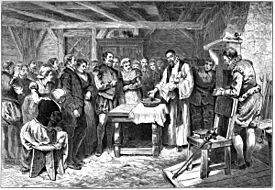
In 1587, Raleigh sent a new group of 115 colonists. Their goal was to start a colony on Chesapeake Bay. John White led them. He was an artist and a friend of Raleigh. White had been on the earlier trip to Roanoke. He was made governor of the 1587 colony. White and Raleigh chose 12 assistants to help with the settlement.
They were told to stop at Roanoke to pick up the small group Grenville had left there. But when they arrived on July 22, 1587, they found nothing. There was only a skeleton, which might have been one of the English soldiers.
Since they found no one, the main pilot, Simon Fernandez, would not let the colonists go back to the ships. He insisted they start the new colony on Roanoke. His reasons are not fully clear. However, some new ideas suggest Fernandez had good reasons. Also, the decision to change the destination to Roanoke might have been made before they even arrived.
White made peace with the Croatoan and other local tribes. But the tribes that Lane had fought with before refused to meet him. Soon after, a colonist named George Howe was killed by a Native American. He was looking for crabs alone in Albemarle Sound.
The colonists convinced Governor White to return to England. He needed to explain their difficult situation and ask for help. About 115 colonists were left behind. This included the men and women who had crossed the Atlantic. It also included White's new granddaughter, Virginia Dare. She was the first English child born in the Americas.
White's Difficult Return to England
White sailed for England in late 1587. Crossing the Atlantic at that time of year was very risky. Plans for a supply fleet were delayed. First, the captain refused to return during winter. Then, England was attacked by the Spanish Armada. This led to the Anglo-Spanish War. Every available English ship joined the fight. This left White with no way to return to Roanoke.
In the spring of 1588, White managed to get two small ships. He sailed for Roanoke. But his attempt to return failed. The ship captains tried to capture several Spanish ships on the way. They wanted to make more money. Instead, they were captured themselves, and their goods were taken. With nothing left to deliver to the colonists, the ships went back to England.
Because the war with Spain continued, White could not try to resupply the colony for three more years. He finally got a spot on a privateering trip. This trip agreed to stop at Roanoke on the way back from the Caribbean. White landed on August 18, 1590. It was his granddaughter's third birthday. But he found the settlement empty. His men could not find any trace of the 90 men, 17 women, and 11 children. There was also no sign of a fight or battle.
The only clue was the word "CROATOAN" carved into a post of the fence around the village. The letters C-R-O were carved into a nearby tree. All the houses and defenses had been taken apart. This meant their departure was not rushed. Before he left the colony, White had told the colonists something important. If anything bad happened, they should carve a Maltese cross on a nearby tree. This would mean they were forced to leave. There was no cross. So, White thought they had moved to Croatoan Island (now Hatteras Island). But he could not search for them. A huge storm was coming, and his men refused to go any farther. The next day, they left.
Early Reports and Theories
Thomas Harriot was a smart man who worked for Raleigh. He may have been on the 1584 trip to Roanoke. He taught the first Roanoke settlers how to navigate. He also sailed to Roanoke with the second group. There, his skills as a naturalist were very important, along with John White's.
Between April 1585 and July 1586, Harriot and White studied the Roanoke area. Harriot wrote down his observations in notebooks. These notebooks did not survive. But Harriot also wrote about the plants and animals in his book A Brief and True Report of the New Founde Land of Virginia. This book was a report to the English government about the colony's progress. Today, historians see it as a way to promote the colony. But it is very important for Roanoke's history because of Harriot's notes on wildlife and Native American life.
Harriot wrote that relations between the Roanoke Native Americans and the English were peaceful. This goes against other historical records. These records talk about fights between the Roanoke Native Americans and Raleigh's leaders, Sir Richard Grenville and Ralph Lane. Harriot did not mention these fights in his report. He also did not mention the colony's problems. He probably thought these facts would stop more settlers from coming. Harriot's book did not reach England until 1588. By then, the "Lost Colony" was already a mystery.
Reports from Jamestown Settlers
When the Jamestown settlement started in 1607, the English tried to get information about Roanoke. The first clear information came from Captain John Smith. He was a leader of the Jamestown Colony from 1608 to 1609.
According to a writer named Samuel Purchas, Smith learned from Chief Powhatan that he had killed the Roanoke colonists. This happened just before the Jamestown settlers arrived. Powhatan said they were living with the Chesepians. These were a tribe related to the Pamlico tribe. They refused to join the Powhatans. This shocking news was sent to England. By 1609, King James and his council believed Chief Powhatan was responsible.
Another source of information was William Strachey. He was the Secretary of the Jamestown colony from 1610 to 1611. Strachey's book, The Historie of Travaile Into Virginia Britannia, seemed to agree with Smith's report. It added more details: The colonists had been living peacefully with a group of Native Americans outside Powhatan's area for over twenty years. Then, they were killed. Powhatan himself seemed to have ordered the killing. This was because his priests had predicted that people from that area would overthrow him. He reportedly showed some English-made iron tools to prove his story.
The information from John Smith and William Strachey led to the common belief that Chief Powhatan killed the Lost Colony. This idea has lasted for over 400 years. However, no bodies were ever found. Also, no archaeological proof has been found to support this claim. Some recent studies suggest that the massacre Powhatan described might have been of the 15 men left behind by the first Roanoke expedition. This would mean the fate of the second colony is still unknown.
What Happened to the Lost Colonists?
Many ideas exist about what happened to the Roanoke colonists. Here are some of the main theories.
Joining Local Tribes
Based on Smith's and Strachey's reports, one idea is that the colonists moved north. They might have joined the Chesepians, the tribe Chief Powhatan claimed to have killed. To travel north, they might have used a small boat called a pinnace and other small boats. If they used boats, they could have gone to other places too.
In her 2000 book, Roanoke: Solving the Mystery of the Lost Colony, historian Lee Miller suggested something else. She thought some survivors might have found shelter with the Chowanoke tribe. Another tribe, called the "Mandoag" by the Jamestown Colony, attacked the Chowanoke. The Mandoag are thought to be either the Tuscarora, who spoke an Iroquois language, or the Eno.
The "Zuniga Map" also supports this idea. This map was drawn around 1607 by Jamestown settler Francis Nelson. It shows "four men clothed that came from roonock" living in an Iroquois area on the Neuse River. William Strachey wrote that at two Native American villages, there were reportedly two-story houses with stone walls. The Native Americans supposedly learned how to build them from the Roanoke settlers. But, as mentioned before, these could also be survivors from Chief Powhatan's attack on the first colonists.
There were also reports of Europeans being held captive in different Native American villages. Strachey wrote in 1612 that four English men, two boys, and one girl were seen at the Eno village of Ritanoc. They were protected by a chief named Eyanoco. Strachey said the captives were forced to work with copper. He also reported that they escaped the attack on the other colonists and fled up the Chaonoke river, which is now the Chowan River in Bertie County, North Carolina.
John Lawson wrote in his 1709 book, A New Voyage to Carolina, that the Croatans on Hatteras Island used to live on Roanoke Island. They claimed to have white ancestors:
A farther Confirmation of this we have from the Hatteras Indians, who either then lived on Ronoak-Island, or much frequented it. These tell us, that several of their Ancestors were white People, and could talk in a Book, as we do; the Truth of which is confirm'd by gray Eyes being found frequently amongst these Indians, and no others. They value themselves extremely for their Affinity to the English, and are ready to do them all friendly Offices. It is probable, that this Settlement miscarry'd for want of timely Supplies from England; or thro' the Treachery of the Natives, for we may reasonably suppose that the English were forced to cohabit with them, for Relief and Conversation; and that in process of Time, they conform'd themselves to the Manners of their Indian Relations.
From the early 1600s to the mid-1700s, European colonists reported meeting Native Americans with gray eyes. These people claimed to be descendants of the colonists. Records from French settlers in 1696 tell of meeting Tuscaroras with blond hair and blue eyes. Since Jamestown was the closest English settlement and had no record of being attacked by Tuscarora, it is likely these fair-skinned Native Americans came from the Lost Colony.
Some researchers believe the colonists and Croatans moved to villages along the Alligator River. This area is called "Beechland." They found old settlement remains there, including coffins with Christian symbols. But this idea is mostly based on old stories and lacks strong proof.
In the late 1880s, a North Carolina politician named Hamilton McMillan found something interesting. His neighbors in Robeson County, who had Native American blood, claimed to be descendants of the Roanoke settlers. He also noticed that many words in their language were similar to old English words. Plus, many of their family names were the same as those listed in Hakluyt's account of the colony.
So, on February 10, 1885, McMillan helped pass the "Croatan bill." He was sure these people were descendants of the Lost Colony. This bill officially called the people around Robeson County "Croatan." Two days later, on February 12, 1885, the Fayetteville Observer newspaper wrote about the Robeson people's origins:
They say that their traditions say that the people we call the Croatan Indians (though they do not recognize that name as that of a tribe, but only a village, and that they were Tuscaroras), were always friendly to the whites; and finding them destitute and despairing of ever receiving aid from England, persuaded them to leave [Roanoke Island], and go to the mainland... They gradually drifted away from their original seats, and at length settled in Robeson, about the center of the county...
However, the case was not fully solved. A similar story says that the now-gone Saponi tribe of Person County, North Carolina, came from the English colonists. But there is no written proof linking the Saponi to the Roanoke colonists.
Other tribes also claim some descent from Roanoke colonists. These include the Catawba (who took in the Shakori and Eno people), and the Coree and the people who call themselves the Lumbee.
Other Theories About the Disappearance
Spanish Attack
Another idea is that the Spanish destroyed the colony. Earlier, the Spanish had destroyed a French colony in South Carolina. They also killed the people at another French colony in Florida. However, a Spanish attack on Roanoke is unlikely. The Spanish were still looking for England's failed colony as late as 1600, ten years after White found it missing.
Dare Stones
From 1937 to 1941, some stones were found. People claimed they were written by Eleanor Dare, Virginia Dare's mother. They told stories of the colonists' travels and deaths. Most historians think these stones are fake. But some still believe at least one stone is real.
Virginia Pars Map Clues
In May 2011, Brent Lane was studying the Virginia Pars Map. John White made this map during his 1585 visit to Roanoke Island. Lane noticed two places where the map had been fixed with patches of paper. These patches were from the same time period as the map. Lane asked researchers at the British Museum what might be under the patches. This led to a new investigation.
On May 3, 2012, researchers announced a discovery. They found "a large, square-shaped symbol with oddly shaped corners." This symbol, which looks like a fort, can be seen when the map is viewed with a light box. Some experts think the colonists moved to this spot. It is now called Salmon Creek in Bertie County, North Carolina.
This new map information led to more study of old artifacts. It also led to new archaeological digs in 2012 and 2014.
Archaeological Finds
In 1998, East Carolina University started "The Croatoan Project." This was an archaeological search into the events at Roanoke. The team dug on Hatteras Island. They found a 16th-century English signet ring made of 10 karat gold. They also found gun flints and two copper coins from the 1670s. These were found at the site of the old Croatoan capital, 50 miles (80 km) from the Roanoke Colony.
Experts traced the lion symbol on the ring. It belonged to the Kendall family. They concluded the ring likely belonged to a Master Kendall. He lived in the Roanoke Colony from 1585 to 1586. If this is true, the ring is the first physical link between the Roanoke colonists and the Native Americans on Hatteras Island.
It is also thought that there is little archaeological proof because of shoreline erosion. A simple fort was found on the north shore. This location is well-known. So, it is believed the settlement must have been nearby. Between 1851 and 1970, the northern shore lost 928 feet due to erosion. If erosion was similar before and during the colony's time, the settlement site might be underwater. Any artifacts or signs of life would be there too. Archaeological digs continue to find interesting clues. More money is being sought to continue these recent excavations.
Weather and Climate Factors
In 1998, a team studied tree rings. Climatologist David W. Stahle and archaeologist Dennis B. Blanton led the team. They used tree ring cores from 800-year-old bald cypress trees. These trees were from the Roanoke Island area and the Jamestown area. They used the rings to figure out past rainfall and temperatures.
The researchers found that the Lost Colony settlers arrived at Roanoke Island during a very bad drought. It was the worst growing-season drought in 800 years. "This drought lasted for 3 years, from 1587 to 1589," the team reported in the journal Science. A map showed that "the Lost Colony drought affected the entire southeastern United States but was especially bad near Roanoke [Island]." The authors suggested that the Croatan people who were shot by the colonists might have been looking for food in the empty village because of the drought.
Lost Colony of Roanoke DNA Project
The Lost Colony of Roanoke DNA Project started in 2007. A group led by Roberta Estes, who owns a DNA-testing company, began it. Their goal is to solve the mystery of the Lost Colony. They use historical records, how people moved around, old stories, and DNA testing. As of 2016, they have not yet found any definite descendants of the colony.
Stories and Plays About the Colony
Pulitzer Prize-winning writer Paul Green wrote a play called The Lost Colony in 1937. He wrote it to celebrate Virginia Dare's 350th birthday. The play suggests what might have happened to the Roanoke Colony. It has been performed at Waterside Theater at Fort Raleigh National Historic Site on Roanoke Island almost every year since, except during World War II. Famous actors like Andy Griffith have been in the play.
The Roanoke Colony was also the main idea for the sixth season of the FX horror TV show American Horror Story.
Images for kids
-
The arrival of the Englishmen in Virginia (1590). An engraving by Theodor De Bry, from a drawing by John White.
-
Plymouth, Devon, was a busy home port for Drake, Gilbert, Grenville, and Raleigh
-
The 1585 attack on Aquascogoc village
-
An artist's drawing of Ralph Lane's Roanoke fort; artist unknown, 1962
-
La Virginea Pars map, by John White
-
Archaeological research dig at Fort Raleigh National Historic Site (2009)
-
A re-creation of the tree carved with "CRO", from a play of The Lost Colony
See also
 In Spanish: Colonia de Roanoke para niños
In Spanish: Colonia de Roanoke para niños


